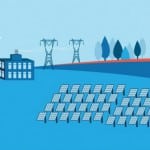While taxpayer support has often led to critical innovations (like the Internet), obviously not every investment pans out, such as the $525 million pumped into Solyndra, which went bankrupt in early September. In a major feature piece for The New York Times, reporters Eric Lipton and Clifford Krauss write that some of the renewable energy projects the government funds would have been built anyway, and that U.S. federal money in certain projects "largely eliminated the risk to the private investors and almost guaranteed them large profits for years to come." They continue:
From 2007 to 2010, federal subsidies jumped to $14.7 billion from $5.1 billion, according to a recent study.
Most of the surge came from the economic stimulus bill, which was passed in 2009 and financed an Energy Department loan guarantee program and a separate Treasury Department grant program that were promoted as important in creating green jobs. …
The windfall for the industry over the last three years raises questions of whether the Obama administration and state governments went too far in their support of solar and wind power projects, some of which would have been built anyway, according to the companies involved.
These types of programs are not new. In fact government has often tried to use its resources to shape the future of certain critical industries, especially energy. But results have sometimes been lacking. In a opinion piece in The Washington Post, energy correspondent Steven Mufson writes:
The Clinch River Breeder Reactor. The Synthetic Fuels Corporation. The hydrogen car. Clean coal. These are but a few examples spanning several decades—a graveyard of costly and failed projects.
Not a single one of these much-ballyhooed initiatives is producing or saving a drop or a watt or a whiff of energy, but they have managed to burn through far more taxpayer money than the ill-fated Solyndra. An Energy Department report in 2008 estimated that the federal government had spent $172 billion since 1961 on basic research and the development of advanced energy technologies.
What does Washington have to show for these investments? And should the government even be in the business of promoting particular energy technologies?
Bjorn Lomborg, the author of the books The Skeptical Environmentalist and Cool It, warns in a Slate article that government’s attempts to kickstart a "green" economy can sometimes lead to unintended consequences:
In Denmark, as across the developed world, politicians are promising that a transition to a greener economy can help to fix the globe’s financial mess. . . .
Denmark serves as a useful test of whether these leaders’ preferred policies yield the environmental and economic benefits that they promise. In tune with international enthusiasm for green energy investment, the Danish government intends to expand wind power dramatically by 2020. That is a significant gesture, but since the country is part of the European Union’s emissions-trading scheme, it will mean absolutely nothing for global CO2 emissions. It will simply make coal power cheaper in other EU countries.
Indeed, costly emission cuts in Denmark and elsewhere are likely to lead to a partial relocation of CO2 emissions to more lenient countries, such as China (where production is less climate-efficient), and thus to an overall increase in global CO2 emissions.
But before you get too depressed about the recent news about renewable energy sources, consider this recent story from Reuters. Futuristic-looking orbiting solar power plants could be a key energy source in the future:
The sun’s abundant energy, if harvested in space, could provide a cost-effective way to meet global power needs in as little as 30 years with seed money from governments, according to a study by an international scientific group.
Orbiting power plants capable of collecting solar energy and beaming it to Earth appear "technically feasible" within a decade or two based on technologies now in the laboratory, a study group of the Paris-headquartered International Academy of Astronautics said.
Such a project may be able to achieve economic viability in 30 years or less, it said, without laying out a road map or proposing a specific architecture.
—Daniel Lippman is a writer for The Infrastructurist, an online magazine covering U.S. infrastructure. Reprinted with permission with minor edits for this republication.









